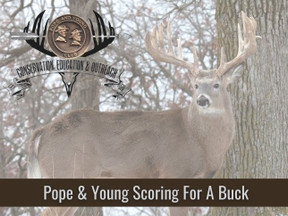Posted by Archery Country on Sep 17th 2020
Pope & Young Scoring For A Buck
Honoring trophy bucks (and other great animals) while also promoting the ethics of fair chase and a conservation commitment among bowhunters, the venerable Pope & Young Club is a more archery-focused counterpart of the well-known Boone & Crockett Club. If you're curious about the Club maybe because you've got a whitetail rack you think might earn a spot in the official records here's a little background on Pope & Young!
Background of the Pope & Young Club
The Pope & Young Club was launched in 1961, but its roots lie decades deeper. Like Boone & Crockett named for the legendary Daniel Boone and Davey Crockett, Pope & Young honors some great hunters in its name.
In 1912, Dr. Saxton Pope became the physician for the Yahi Indian Ishi who'd walked out of the Northern California backcountry near Mount Lassen the year before, having up till then practiced the traditional subsistence lifestyle of his people. Pope became fascinated with Ishi's prowess with the bow and arrow. Through Will Compton, Pope met Arthur Young, a journalist and athlete also intrigued by archery; the two became devoted students of bowhunting as taught by both Ishi and Compton.
Ishi tragically died only a few years after materializing from the wilderness, but Pope and Young continued to refine their archery skills and equipment in the 1920s and 1930s on hunting trips in North America and Africa. Partly because of their exploits and advocacy, interest in the ancient art of bringing down game with bow and arrow began to rise in the hunting community. In 1930, Wisconsin certified the bow as a legal hunting weapon, and other states soon followed suit.
The burgeoning interest in modern bowhunting and the inspiration of the hunting records maintained by the Boone & Crockett Club led to a desire for a similar organization more specifically relevant for bowhunters. Christened in honor of Saxton Pope and Arthur Young, the Pope & Young Club is, as the organization’s history notes, “dedicated to scientific records keeping, sound conservation practices, quality hunting and fair chase.
Boone & Crockett vs. Pope & Young
While partly based on the Boone & Crockett model, there are significant differences between the B&C and Pope & Young systems. Not only is Pope & Young bowhunting-specific, but it's records only consider animals taken with equipment meeting its standards: A deer killed by a crossbow (not considered a hunting bow by Pope & Young) or discovered dead by a hunter, for example, would not be Pope & Young eligible, though they'd be valid by B&C standards. Another difference is the acceptability of antlered trophies in velvet for Pope & Young records.
Pope & Young Requirements/Eligibility
To be eligible for Pope & Young records, trophies must not only have been taken in accordance with all state/provincial game laws but also with the Club's Rules of Fair Chase, which you can study here.
In terms of buck racks, trophies are only eligible for consideration for Pope & Young Club records if they've been stored at normal room temperature and humidity levels for a minimum of 60 days following the kill, and the skull plate must be intact and unaltered. (Besides that drying window, there are no time limits for submitting trophies to the Pope & Young database.)
A wide variety of huntable game species and subspecies are eligible for the Pope & Young Club records. They include both typical and non-typical deer in the following taxonomic categories: whitetails, Coues deer, mule deer, and Columbian and Sitka blacktails. Other critters include everything from various subspecies/ecotypes of moose, elk, and bighorn sheep to bison, muskoxen, cougars, and four categories of North American bear.
Measurements, Scoring, and Records
Pope & Young Club trophies are assessed by official measurers who do this important work in a volunteer capacity. You can search for Pope & Young measurers near you right here.
Obviously there are specific trophy-scoring standards for each of the many eligible species, but we're going to focus on deer here and primarily whitetails. When evaluating typical or non-typical whitetail racks, a Pope & Young measurer considers values and characteristics such as the greatest antler spread, the tip-to-tip spread, the inside spread of the main beams, the number of points on each antler, and the length of each point. Becoming intimately familiar with these measurements can help bowhunters assess potential trophy bucks in the field and decide whether or not to take the shot.
To qualify for the Pope & Young Club records, a typical whitetail rack must score at least 125 inches, and a non-typical must score at least 155 (15). Analogous values for mule deer are 145 and 170 (12 4/8); for Coues deer 70 and 80(5); and for Columbian black-tailed deer 95 and 115 (10). Sitka blacktails (not divided into typical and non-typical categories) must score at least 75, meanwhile.
The world record Pope & Young typical whitetail was taken in 1965 by Mel Johnson in Illinois, and holds a score of 204 4/8. A new record non-typical whitetail was confirmed in 2019: a buck taken the year before by Luke Brewster, also in Illinois, which earned a score of 327 7/8. (This exceeded by more than 33 inches the previous record-holding non-typical whitetail, been killed in 2000 by Michael Beatty.)
Learn more about the Pope & Young Club, what it stands for, and how to get your buck scored at the official Club website.

